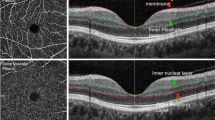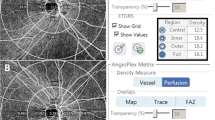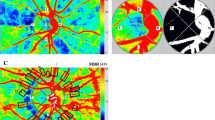Abstract
The eye is a target organ as well as an established prognostic indicator of arterial hypertension. Based on the ophthalmoscopically visible alterations, several classifications, the majority of them grading hypertensive fundus changes into four stages, have been suggested. Moreover, assessment of hypertensive alterations of the perivoveal microcirculation has become possible by means of fluorescein angiography. However, it has not yet been evaluated whether an angiographic equivalent for the ophthalmoscopic classifications exists. We therefore compared the perifoveal microcirculation of hypertensive patients who were staged according to the classification of Neubauer, a modification of the classification of Keith and Wagener, among each other and with that of normal subjects. According to Neubauer, who distinguishes between fundus hypertonicus (stages I–II) and hypertensive retinopathy (stages III–IV), we divided the patients (n = 143) into four groups: stage I (n = 49), stage II (n = 72), stage III (n = 16), and stage IV (n = 6). All patients underwent fluorescein angiography performed with a scanning laser ophthalmoscope. By means of digital image analysis we quantified the following parameters: (1) perifoveal intercapillary area (PIA), (2) the area of the foveal avascular zone (FAZ), and (3) capillary blood velocity (CBV). All patients with arterial hypertension demonstrated a rarefaction of the perifoveal capillary bed and a decrease of capillary blood velocity as compared with normal subjects. Significant changes of PIA (P < 0.05) and CBV (P < 0.05) were seen between mild (I–II) and severe stages (III–IV) of hypertensive retinopathy, but neither between stages I and II nor between stages III and IV. Our findings indicate significant angiographic differences between mild and severe form of hypertensive retinopathy, however, unlike in ophthalmoscopy, a differentiated division into four stages is not possible.
This is a preview of subscription content, access via your institution
Access options
Subscribe to this journal
Receive 12 digital issues and online access to articles
$119.00 per year
only $9.92 per issue
Buy this article
- Purchase on Springer Link
- Instant access to full article PDF
Prices may be subject to local taxes which are calculated during checkout



Similar content being viewed by others
References
Kannel WB . Fifty years of Framingham Study contributions to understanding hypertension J Hum Hypertens 2000; 14: 83–90
Walsh JB . Hypertensive retinopathy. Description, classification, and prognosis Ophthalmology 1982; 89: 1127–1131
Rath EZ, Frank RN, Shin DH, Kim C . Risk factors for retinal vein occlusions. A case-control study Ophthalmology 1992; 99: 509–514
Klein R, Klein BE, Moss SE . The relation of systemic hypertension to changes in the retinal vasculature: the Beaver Dam Eye Study Trans Am Ophthalmol Soc 1997; 95: 329–348
Wolf S et al. Retinal hemodynamics inpatients with chronic open-angel glaucoma Ger J Ophthalmol 1995; 4: 279–282
Arend O, Ruffer M, Remky A . Macular circulation inpatients with diabetes mellitus with and without arterial hypertension Br J Ophthalmol 2000; 84: 1392–1396
Wolf S et al. Quantification of retinal capillary density and flow velocity inpatients with essential hypertension Hypertension 1994; 23: 464–467
Neubauer H . Augenhintergrundsbefunde bei arterieller Hypertension? Internist (Berl) 1974; 15: 485–496
Wolf S, Arend O, Reim M . Measurement of retinal hemodynamics with scanning laser ophthalmoscopy: reference values and variation Surv Ophthalmol 1994; 38: (Suppl): S95–S100
Wolf S et al. Retinal capillary blood flow measurement with a scanning laser ophthalmoscope. Preliminary results Ophthalmology 1991; 98: 996–1000
Arend O et al. Macular capillary particle velocities: a blue field and scanning laser comparison Graefes Arch Clin Exp Ophthalmol 1995; 233: 244–249
Littmann H . Zur Bestimmung der wahren Grö eines Objektes auf dem Hintergrund eines lebenden Auges Klin Mbl Augenheilk 1988; 192: 66–67
Holm S . A simple sequentially rejective multiple test procedure Scand J Statist 1979; 6: 65–70
Kagan A, Aureli E, Dobree J . A note on signs in the fundus oculi and arterial hypertension: conventional assessment and significance Bull World Health Organ 1966; 34: 955–960
Wulle KG et al. Bedeutung der Fundus-Beurteilung bei der Stadieneinteilung der Hochdruck-Krankheit im Vergleich zum Elektrokardiogramm und zur Nierendurchblutung Klin Monatsbl Augenheilkd 1986; 189: 463–466
Palatini P et al. Role of ophthalmoscopy in arterial hypertension: a problem revisited Cardiologia 1991; 36: 713–722
Lund OE . Fundus hypertonicus: Spiegel der Niere oder des Gehirns? MMW Munch Med Wochenschr 1974; 116: 613–616
Kutschbach P et al. Einfluss unterschiedlicher antihypertensive Monotherapien auf die perifoveale Mikrozirkulation bei Patienten mit arterieller Hypertonie Ophthalmologe 1996; 93: 699–702
Remky A et al. Perifoveal capillary network inpatients with acute central retinal vein occlusion Ophthalmology 1997; 104: 33–37
Lafaut BA, De Vriese AS, Stulting AA . Fundus fluorescein angiography ofpatients with severe hypertensive nephropathy Graefes Arch Clin Exp Ophthalmol 1997; 235: 749–754
Spitzer S et al. Koinzidenz zwischen hypertensiven Augenhintergrundveränderungen und Regulationsstörungen der peripheren Mikrozirkulation: Teil I – Haut Klin Monatsbl Augenheilkd 1990; 196: 81–85
Kutschbach P et al. Retinal capillary density inpatients with arterial hypertension: 2-year follow-up Graefes Arch Clin Exp Ophthalmol 1998; 236: 410–414
Antonios TF et al. Structural skin capillary rarefaction in essential hypertension Hypertension 1999; 33: 998–1001
Prewitt RL, Chen II, Dowell R . Development of microvascular rarefaction in the spontaneously hypertensive rat Am J Physiol 1982; 243: H243–H251
Hansen-Smith F, Greene AS, Cowley AW Jr, Lombard JH . Structural changes during microvascular rarefaction in chronic hypertension Hypertension 1990; 15: 922–928
Folkow B . Hypertensive structural changes in systemic precapillary resistance vessels: how important are they for in vivo haemodynamics? J Hypertens 1995; 13: 1546–1559
Bhutto IA, Amemiya T . Vascular changes in retinas of spontaneously hypertensive rats demonstrated by corrosion casts Ophthalmic Res 1997; 29: 12–23
Wagener HPCG, Gipner JF . Classification of retinal lesions in the presence of vascular hypertension Trans Am Ophthalmol Soc 1947; 45: 47–73
Scheie HG . Evaluation of ophthalmoscopic changes of hypertension and arteriolar sclerosis Arch Ophthalmol 1953; 49: 117–118
Leishman R . The eye in general vascular disease: hypertension and arteriosclerosis Br J Ophthalmol 1957; 41: 641–701
Keith NMWH, Barker NW . Some different types of essential hypertension: their course and prognosis Am J Med Sci 1939; 197: 332–343
Fuchs FD et al. Study of the usefulness of optic fundi examination ofpatients with hypertension in a clinical setting J Hum Hypertens 1995; 9: 547–551
Dimmitt SB et al. Usefulness of ophthalmoscopy in mild to moderate hypertension Lancet 1989; 1: 1103–1106
Schubert HD . Ocular manifestations of systemic hypertension Curr Opin Ophthalmol 1998; 9: 69–72
Dodson PM et al. Hypertensive retinopathy: a review of existing classification systems and a suggestion for a simplified grading system J Hum Hypertens 1996; 10: 93–98
Acknowledgements
This investigation was supported by the Deutsche Forschungsgemeinschaft (DFG) grant Re 152/26–2 and Wo 478/8–3.
Author information
Authors and Affiliations
Corresponding author
Rights and permissions
About this article
Cite this article
Pache, M., Kube, T., Wolf, S. et al. Do angiographic data support a detailed classification of hypertensive fundus changes?. J Hum Hypertens 16, 405–410 (2002). https://doi.org/10.1038/sj.jhh.1001402
Received:
Revised:
Accepted:
Published:
Issue Date:
DOI: https://doi.org/10.1038/sj.jhh.1001402
Keywords
This article is cited by
-
Hypertensive eye disease
Nature Reviews Disease Primers (2022)
-
Systemic hypertension associated retinal microvascular changes can be detected with optical coherence tomography angiography
Scientific Reports (2020)
-
Circulatory parameters in the retrobulbar central retinal artery and vein of patients with diabetes and medically treated systemic hypertension
Graefe's Archive for Clinical and Experimental Ophthalmology (2009)
-
Hypertension and the eye: changing perspectives
Journal of Human Hypertension (2002)



